Bhitarkanika National Park, Odisha.
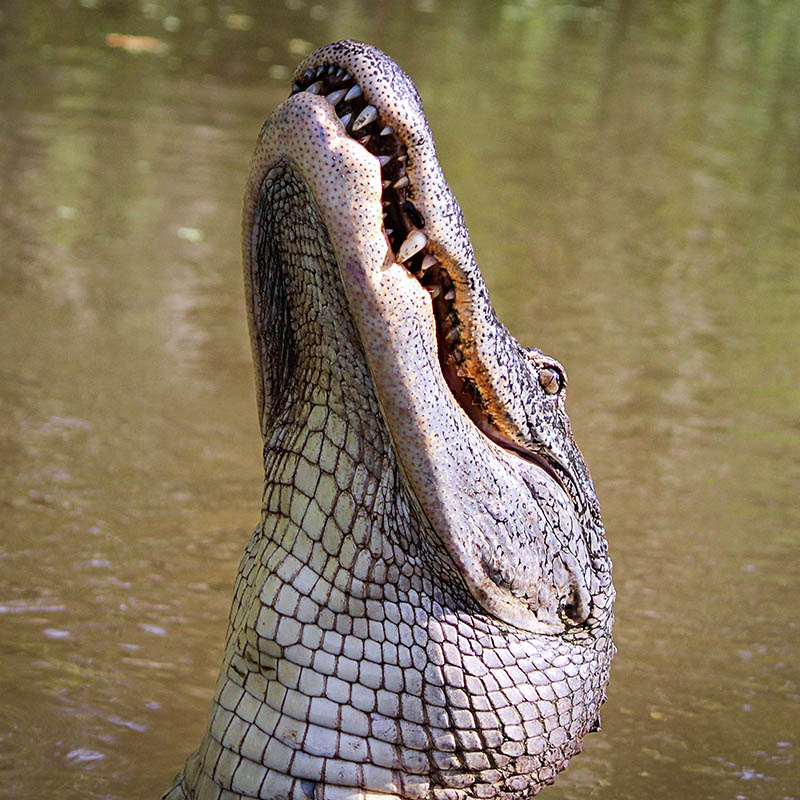
- : Khola, Dangmal (Rajnagar), Bhitarkanika,Kendrapara-754248, Odisha. (Northeast region of Kendrapada district, Odisha.).
- : Distance from Airport- Bhubaneswar-160 km. & Distance from Bhadrak Railway Station-60 km..
- : All days of the week - 8:00 AM - 5:00 PM.
- : As per convenience within time limit..
- : October- March at sunrise or sunset..
- : OTDC (Odisha Tourism Dev. Corp.) provides..
 Basic info
Basic info
Located on the north-eastern region of Kendrapada, the Bhitarakanika Wildlife Sanctuary is considered as one of the most impressive wildlife sanctuaries in Asia. The wetlands stretch to cover 672 square kilometers and houses the very dynamic and salt tolerant mangrove trees. Crossed by a thick network of brooks with the Bay of Bengal to it’s east, this impressive wildlife sanctuary is home to over 215 species of birds which include the winter migratories flying in from Europe and central-Asia. It is inundated by the rivers Brahmani, Baitarani, Dharmra and Pathsala.
Another rarity about Bhitarakanika’s inhibitation is that of the Giant Salt Water Crocodiles to it’s ecosystem along with it’s various other varities.
The wetland is rich and diverse in homing various species of avifauna, reptilain and mammalian population.
It was designated to it’s National Park status on 16 September 1988 and as a RAMSAR site by UNESCO on 19 August 2002.
 Tourist attractions
Tourist attractions
When it comes to sightseeing, leaving without getting the sight of the giant Saltwater Crocodile, some of which grow upto 23 feet in lenght, along with the Monitor Lizard, Olive Turtles and the King Cobra is definitely a loss.
Spotted deers and wild boars are abundant in all the major locations. A walk to the many creeks and riverines within the park and you would definitely be able to see the eight varities of Kingfishers.
The boat ride from Khola to Dangmal or vice versa is recommended as it passes alongside an artificial creek and through the dense mangrove forest which provide a glimpse into the Sanctury’s ecosystem and fauna.
Chilika lake, Odisha.
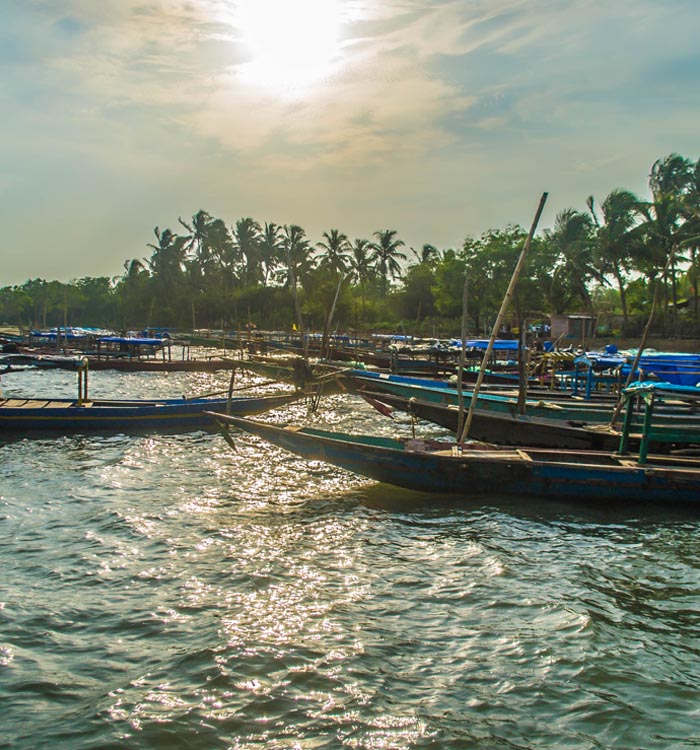
- : Chilika, Khordha, Puri, Odisha, 752001..
- : Nearest Airport-Bhubaneswar- 103.6 km &Nearest Railway Station-Bhubaneswar-102.8 km. Can only be reached by Road from Bhubaneswar..
- : All days of the week 6:00 AM - 7:00 PM.
- : 2 to 3 hours.
- : The best time to visit the Chilika Lake is the winter months of November to February, when the variety of migratory birds can be witnessed. June to September, which is the rainy season must be avoided..
- : Budget & Luxury Hotels available..
 Basic info
Basic info
The Largest Brakish Water and Shallow Lagoon, Chilika, is situated on the east coast of India connecting to Bay of Bengal. It is spread over 1,100 sq km normally but during summer it sinks to 900 sq km and rainy season expands it to 1165 sq km.
It is one of the most tourist attracted hot spot, and because of its rich variety in biodiversity within itself, Chilika has been designated as the first “Ramsar Site” in India. It is home to various vulnerable and endangered species which has been listed in International Union for Conservation of Nature (IUCN) Red List of threatened Animals. The Nabala Island which is situated within the lagoon has been notified as a Bird Sanctuary under Wild Life (Protection) Act, the National Wetlands, mangroves and coral reefs Committee of Ministry of Environment and Forests, Government of India has also identified the lagoon as a priority site for conservation and management as it supports congregation of migratory birds in the country particularly during winter.
Irrawaddy dolphins is the most important attraction of Chilika Lake which is only available here.
For centuries fisher folk evolved exclusive rights of fishing through a complex system of partitioning the fisheries of the lake, harvested the lake in a relatively sustainable fashion and developed variety of fishing techniques which profit them a lot. This is a must go tourist site.
Daringbadi (Kashmir of Odisha), Odisha.
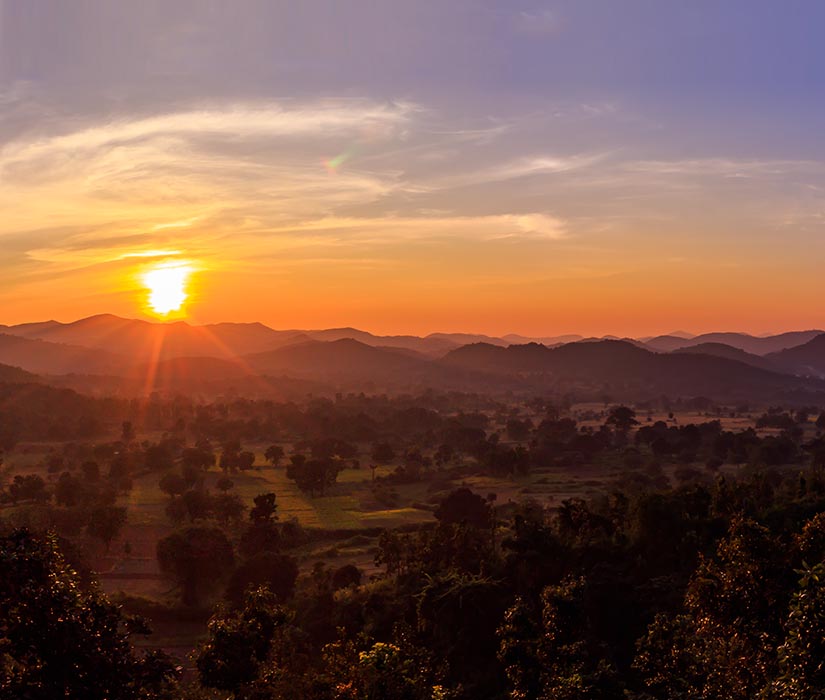
- : Daringbadi, Kandhmal, Odisha - 762104.
- : Nearest Airport-Bhubaneswar-247 km. Nearest Railway Station-Berhampur-121 km..
- : This place can be visited all the year round but the best timing is winter season that is November and December. Rainy season are not advisable.
- : As per convenience.
- : .
- : Budget & Luxury Hotels available..
 Basic info
Basic info
Daringbadi, situated at a height of 3,000 ft, is one of the popuar tourist spot in Odisha. This hill station which is in the Kandhamal district is also known as “Kashmir Of Odisha” due to its climatic similarity. This is the only place in Odisha which experiences snowfall and is a very nice summer resort. Many a times during winter it has recorded temperatures below zero degree celcius. This place is mostly inhabited by Dongoria Kondh, a tribal section of odisha.
Its etymology has a fact, that, during the British rule in India, at this place a British Officer was in-charge of this placed, his name was Daring. The locals thus named it as DaringBadi (where badi-means village).
It attracts lots of tourists all the year round and people enjoy the lush greenery, prolific vegetation and relaxing water bodies. Visitors get captivated of its beautiful scenic beauty.
The meadows which are itself colourful, is best for picnic lovers and makes it a suitable for trekking and camping in its towering hills along with the beautiful forests. The exotic facades of Daringbadi lead many visitors speechless and their experiences knew no bounds. It is such a place which almost has every thing covered within. The coffee plantation is also one of its important feature which attracts tourists a lot.
Not only its climate but also it has many things to visit in and around this place.
It is a very nice place to visit for people who want peace and are trying to escape from the hustle and bustle of the busy city life.
Dhauli Shanti Stupa, Odisha.
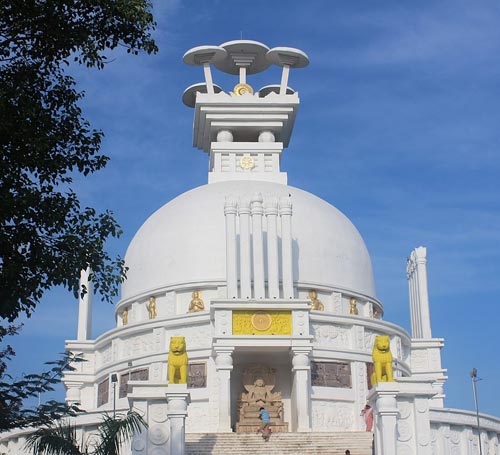
- : Dhauli, Bhubaneswar, Odisha -752104..
- : Nearest Airport-Bhubaneswar-10 km. Nearest Railway Station-Bhubaneswar-12 km..
- : All days of the week from 06:00 AM-06:00 PM.
- : 1 hour..
- : November-March..
- : Budget & Luxury Hotels available..
 Basic info
Basic info
Across the river Daya, about 8km south from the present capital city of Odisha, Bhubaneswar, is situated the major edicts of Ashoka engraved on a mass of rock on the top of a hill. Dhauli, the name by which the place is know, is said to be the area of the quite ferocious and bloody battle of Kalinga which was won by the then Emperor of the India, Ashoka of the Mauryan dynasty in 265 BC. It is said that even though the King was victory on his side, the horror of having slain over 1,50,000 people, that the Daya river is said to have turned red with the blood of the deceased. The misery inflicted on the common citizens that impacted in the mind of Emperor Ahoka with remorse and brought about a sudden change of heart. In the realisation, Ashoka gave up his ambition of dig-vijaya (military conquests in all the four directions) led his power in to dharma-vijaya (spiritual conquest)
The battle was said to have a huge impact on the Emperor, who thereafter renounced his path of violence to embrace Buddhism and publicised his new maxims in rock edicts installed in different parts around his empire. One of those edicts, which are present at Dhauli hills, proclaims, “All men are my children”, an inscription in ancient brahmi script, expresses his concern to ensure impartiality, non-violence, justice and compassion. The top of the rock sculpted into an imposing elephant’s head is related to a dream seen by mother of Buddha where he is seen to be ascending to her womb in the form of an elephant. The stupa is in white colour, which has a symbolic meaning of peace. From Dhauli stupa people can enjoy a great view of the river Daya and even can see from there the Hills of Khandagir and Udaygiri (situated at a distance of 20 km from the shrine) which is on the other side of the city of Bhubaneswar.
Ashoka also built many chaityas, stupas and pillars at Dhauli. Currently, it is one of the earliest rock structure in the history of India and it is said that Dhauli was a special weakness for the Emperor as it was where the battle was fought and he realized his ways. He saw to it that Dhauli became an important centre of Buddhist activities.
Golden Beach, Odisha.
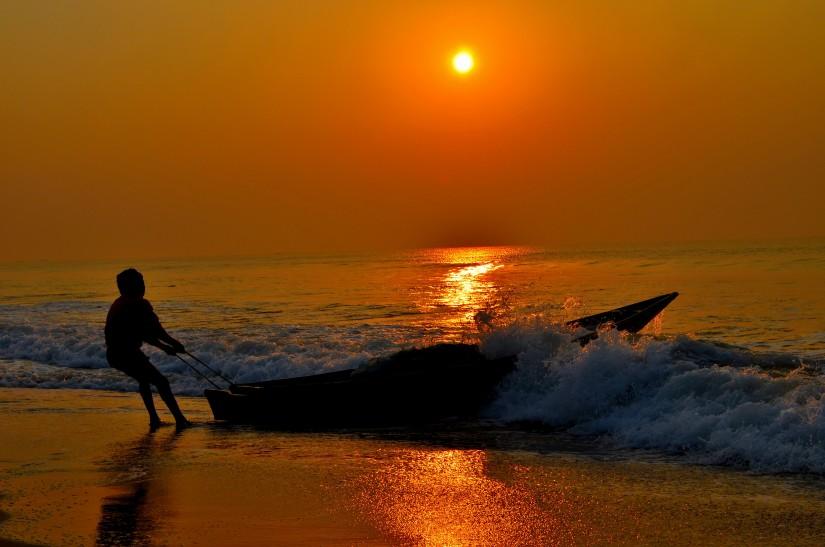
- : Puri Beach Road, Puri, Odisha, 752002..
- : Nearest Airport-Bhubaneswar- 59km. Nearest Railway Station- Puri -2.7km By cabs or buses..
- : Sunrise to sunset.
- : As per convenience (best 2 hrs).
- : the best timing in the months of December to February..
- : Budget & Luxury Hotels available..
 Basic info
Basic info
Puri Beach is known as one of the best holiday destinations all over the world. Lying on the shore of Bay of Bengal it is a Hindu sacred place. It has stretched to 2 kms. The sunrise and sunset at the beach is the best for beach lovers. Due to the white sand the beach appears golden in color thus derived its name. Bathing can be done at the beach and also there are public washrooms located near the beach to facilitate local and foreign visitors to wash away the sand.
Previously this beach was used for business purpose with other southeastern countries. Fishing is the main occupation of this place.
The beach is known for many reasons, as it holds the Annual Beach Festival for five days in the month of November which is organized by the conglomerate efforts of Indian Ministry of Tourism, the Development Commissioner of Handicrafts and Eastern Zonal Cultural Centre, Kolkata.
The beach is also famous for the sand art and sculptures made by the world famous, International Award winning local artist, Sudarshan Patnaik, which is generally inspired by sculptures covering the temple walls, characters and episodes from the mythology and also the contemporary events.
Gopalpur on Sea Beach, Odisha.
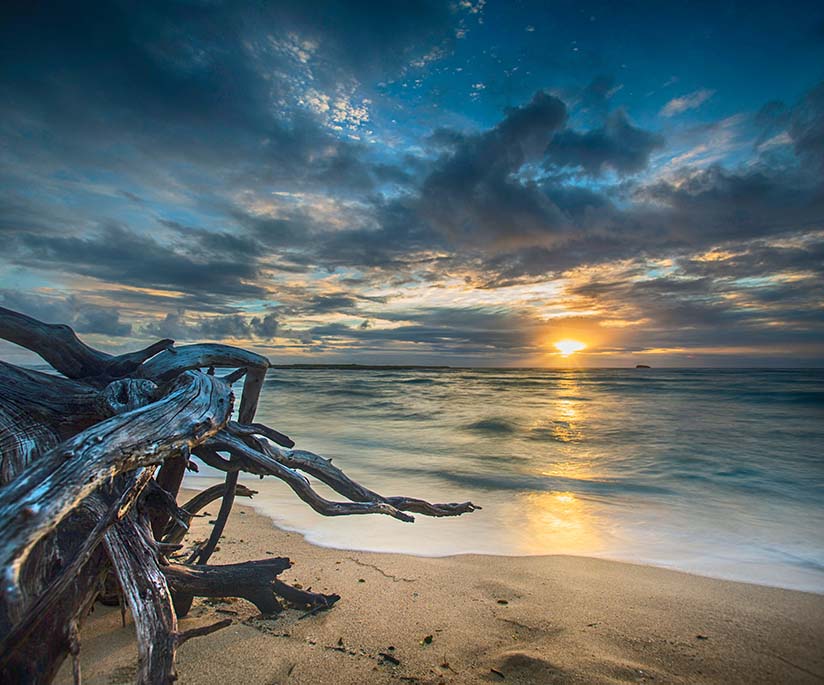
- : Gopalpur Beach, Gopalpur, Dist:-Ganjam, Odisha, 761002..
- : Nearest Airport- Bhubaneswar- 165.9 km. Nearest Railway Station- Berhampur-16.1 km..
- : October to March will be best (due to its moderate climate it can be visited all the year round)
- : As per convenience.
- : .
- : Budget & Luxury Hotels available..
 Basic info
Basic info
Gopalpur-On-Sea beach is among one of the most sought for and noted beaches in Odisha after Puri Beach, which attracts visitors and tourists all the year round.
The nomenclature of this place was done after a temple dedicated to lord Krishna (A Hindu God also called as Gopal) was built in the 18th century.
Just 16 km away from the city of Berhampur facing the Bay of Bengal, it is this beach which was once a commercial port, since trade was catching its speed with Burma (now Myanmar) during those days.
Before become a trading point it was previously an obscure little fishing village, which grew into a wealth hub under the control of Soraine family. It was this family which made the port, the lighthouse and the Albert Hotel along with establishing a local fishing industry and a trade route to Burma.
The family also made a bylaw for the locals, which allowed the people to build a house, within a perimeter and that if they could light a fire in the fireplace overnight, then they will be allowed to keep the land and house (on the backwaters) as their own.
During the British Rule this port grew into an important hub for the East India Company and the Company built large warehouses and godowns. It was also famous for rice from Rangoon. The functioning of this port stopped after the Second World War in 1942. Several bungalows and mansions of European traders which now stand as ruins give a picturesque of ancient colonies.
Being an old harbour it has lots of jetties which was renovated by the initiative taken by Government of Odisha in 1970s. The old jetty is one of the most tourist attracted place in Gopalpur, this jetty was a commercial point for the traders during the medieval period. It also holds within itself an old sea light house with red and white strips on its beach which also a tourist attraction.
Hirakud Dam, Odisha.
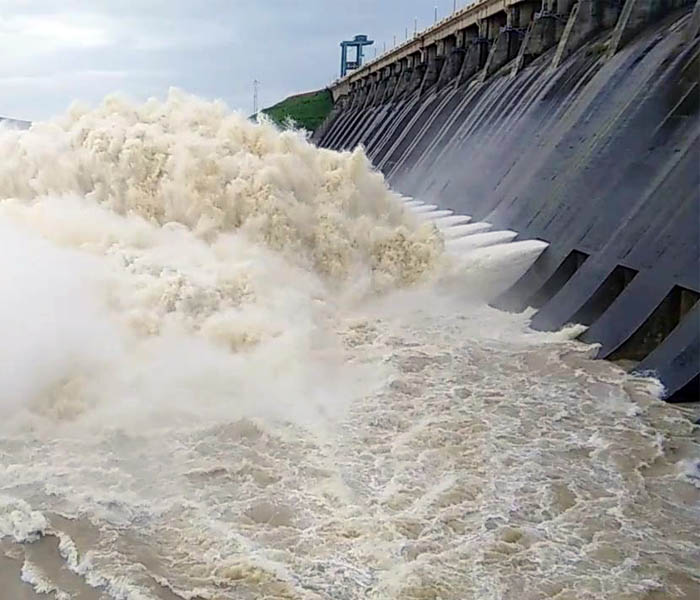
- : Hirakud Dam Road, Hirakud, Dist-Sambalpur, Odisha -768016. (15 km from Sambalpur, Odisha).
- : Nearest Airport-Bhubaneswar- 278km. Nearest Railway Station-Sambalpur-43.7 km..
- : 6:00 am to 5:00 pm.
- : Around 1 hr for to and fro over the dam..
- : September to March.
- : Budget & Luxury Hotels available..
 Basic info
Basic info
Hailed as one of the longest man-made dams in the world, the Hirakud dam was constructed across the Mahanadi river in Odisha in the year 1956 and was inaugurated by the then Prime Minister Jawaharlal Nehru. It has an ideal atmosphere for wildlife to flourish because of it’s location. The Hirakud reservoir is also situated in it’s close vicinity of the dam and is the focal point of interest for tourists and large flocks of birds as well. Many migratory Common Pochard, Red-crested Pochard and Great Crested Grebe can be seen there.
Any nature lover is tend to enjoy the quaint atmosphere and lush greenery that is in abundance at the Hirakud Dam. The dam stretches over a length of 4.8 kms (main section) and the whole dam is 25.8 km. It spans between Burla and Hirakud hill. In addition, the dam is also responsible for 307.5 megawatt power generation and irrigation of 3,90,000 acres of land area stretching across Sambalpur, Bargarh and Subarnapur district. Situated near it is a hill called Busharaj hill. At the peak of the hill Budharaj, birds also fly in towards this destination during winter.
A temple dedicated to Lord Shiva is near it.This shrine has breathtaking views of the dam from its summit. Another temple which is a must-visit in Hirakud is the Ghanteshwari Temple which served as a lighthouse for the incoming ships and the bells were used to warn the sailors. There are also two tower - Gandhi Minar and Nehru Minar (observational tower). From these towers, one can have a bird-eye view of the surrounding. Cattle Island, Vimleshwar Temple, Huma Temple, and Ushakothi Wildlife Sanctuary are some of the nearby tourist attractions from the dam.
Visit this destination for a tranquil getaway in the lap of nature.
Jagannath Temple, Odisha.
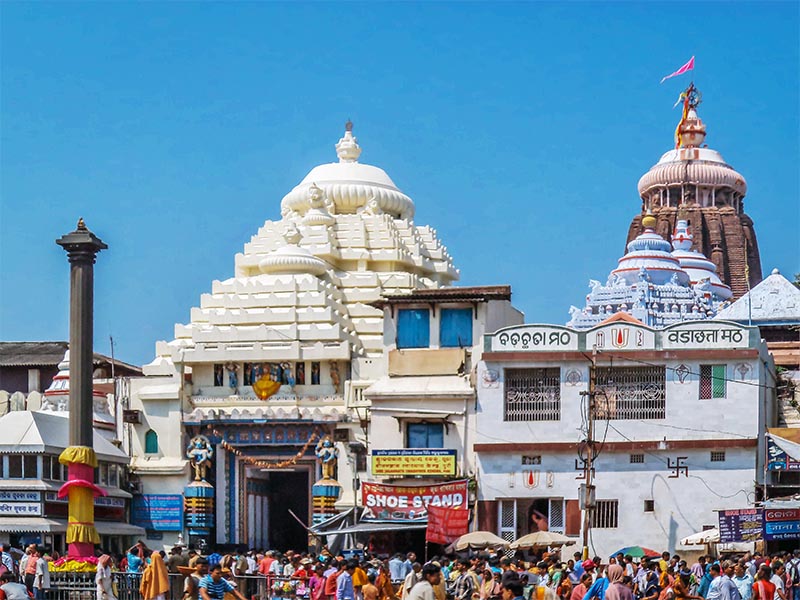
- : Grand Road, Puri, Odisha 752001..
- : Nearest Airport-Bhubaneswar- 59km. Nearest Railway Station- Puri -2.7km..
- : All days of the week - 5:00 AM - 11:00 PM.
- : 1 to 2 hours.
- : December to February..
- : Budget & Luxury Hotels available..
 Basic info
Basic info
Situated in the beautiful beach town of Odisha, Puri’s Jagannath temple is one of the important pilgrimage destinations for Hindus, especially the Vaishnava traditions. It is one of the four Dhams in Hinduism. The temple in the 10th century still holds high significance amongst the worshippers. The temple in it’s present form was rebuilt from it’s original form built by King Anantavarman Chodaganga Deva first of the Eastern Ganga dynasty.
The temple is famous for it’s annual chariot festival known as Ratha Yatra in which the three pinciple deities are pulled on huge and expensively decorated temple cars. The main difference of the temple between other Hindu temples is the idol of the Lord is made of wood unlike stones and ornaments as found commonly. The wood idol is ceremoniously replaced every twelve or nineteen years by an exact replica.
Lord Jagannath is worshipped as Vishnu or Narayana or Lord Krishna and Lord Balabhadra as Shesha Nag.
The temple aslo has many interesting facts which defy the laws of science. One of them is the flag of the temple which always flows in the opposite direction of the winds course. Many people have also reported that the temple has no shadows at any time of the day from any directions possible. Also the Parsadam prepared everyday never gets wasted no matter the visitor count be 2000 or 200000.
Another interesting phenomena that surprises people around the world is the muted audibility of the ocean waves once you enter the Singha Dwara. This is said to be more prominent in the evening.
Konark Sun Temple, Odisha.
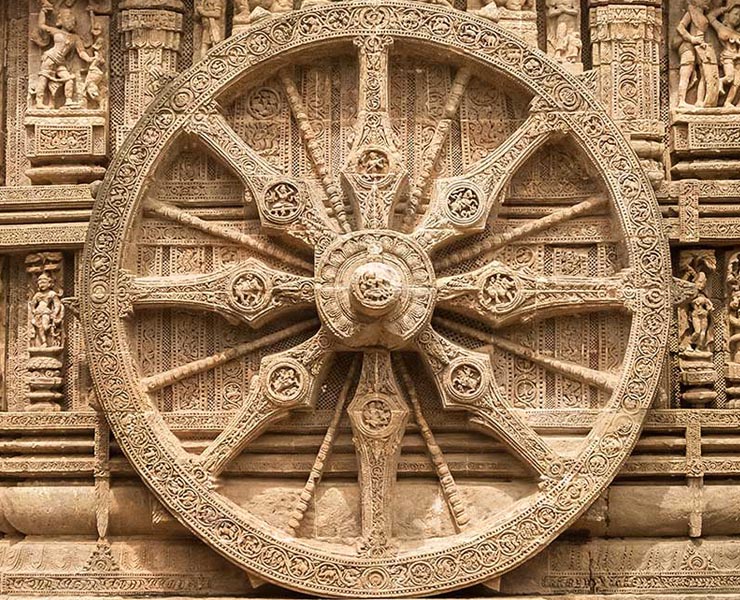
- : Konark, Odisha, 752111..
- : Nearest Airport-Bhubaneswar- 61.6 km. Nearest Railway station-Puri-31 km..
- : October to February 6 AM- 8 PM.
- : 1 hrs..
- : .
- : Budget & Luxury Hotels available..
 Basic info
Basic info
The Konark Sun Temple, located in the eastern part of Odisha is known to be an Architectural marvel of Eastern India and an important symbol of the Indian heritage. It comes from the word Kona which means corner and Arka which means Sun and is dedicated for the worship of the Sun God.
The temple is designed in such a manner that the three images of the Sun God at different sides of the temple will be catch the rays of the morning, afternoon and evening light.
Built in the 13th century by King Narasimha I with the help of 1200 artisans with the construction period of 12 years, The Konark Sun Temple is a massive conception of artistic magnificence and engineering dexterity. The Temple used to considered as a chariot for the Sun God because of its gorgeously decorated chariot mounted on 24 wheels and drawn by 7 magnificent and mighty horses.
The temple is not only known for its architectural genius but also for its sophisticated and abundant sculptural works. Declared as a UNESCO world heritage site in 1984, it remains as the top pilgrimage site for Hindus.
Although what remains today is only the entrance and the main temple for its deity is in ruination, The Sun temple reflects the mastermind of the architects who imagined and built it.
Lingaraj Temple, Odisha.
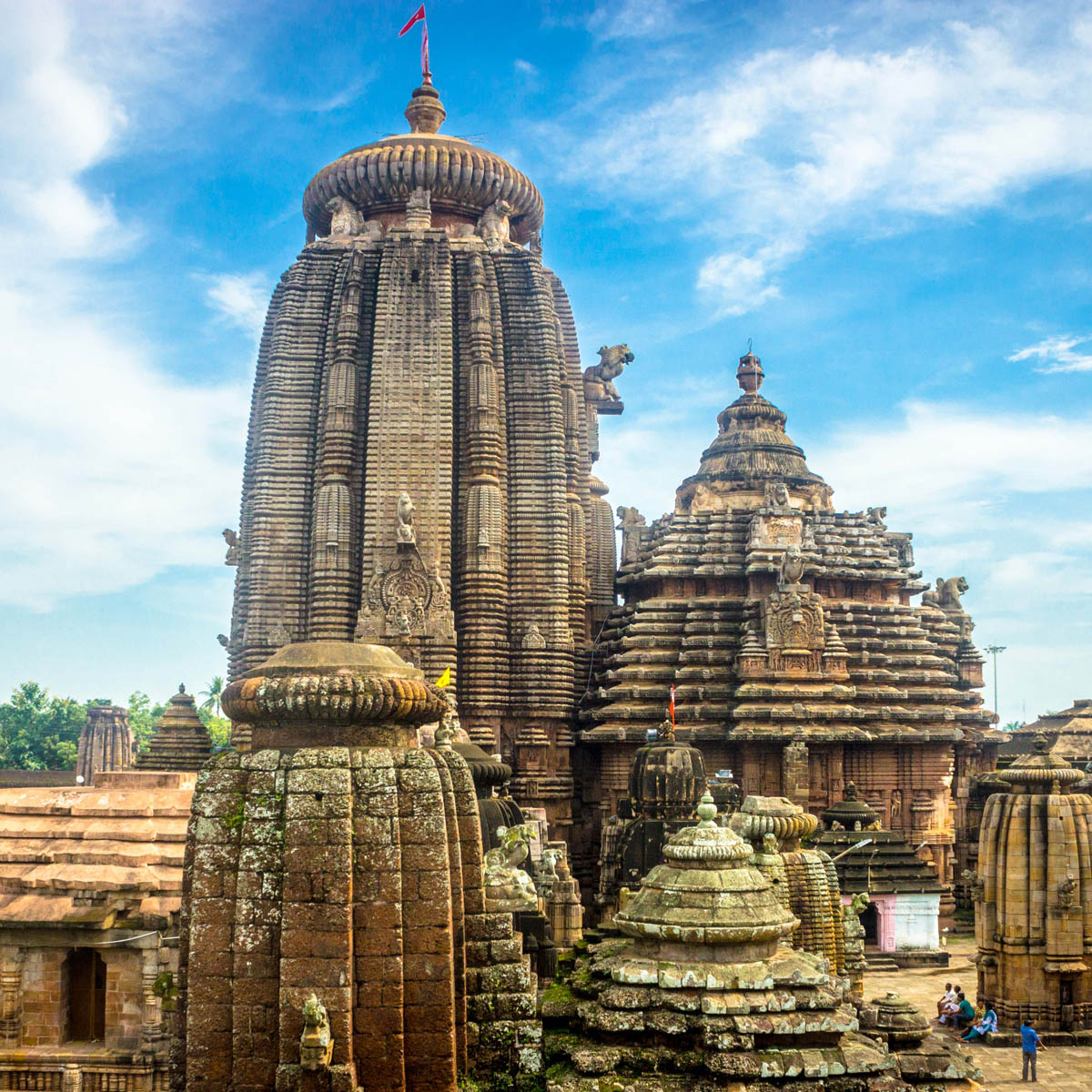
- : Ratha Road, Lingaraj Nagar, Old Town, Bhubaneswar, Pin-751002..
- : Nearest Airport-Bhubaneswar-5 km. & Nearest Railway Station-Bhubaneswar-3 km..
- : 5 am-9 pm - till the barricade inside the temple, 2 pm-4 pm - to go beyond the barricade near the deity of the temple On All Days.
- : On non festival time 1 hr.
- : best month December to March. In festival season 3 to 4 hrs..
- : Budget & Luxury Hotels available..
 Basic info
Basic info
Lingaraj Temple, the second oldest temple after Parashurameshvara Temple (7th Century) in Odisha, has been constructed in the 11th century by the then ruler Jajati Keshari of Somavamsi dynasty, after shifting his capital from Jaipur to Bhubaneswar (previously Ekambra Khetra).
This is the largest temple in the city and one of the oldest temples which is active in worship.
Literarlly Lingaraj means the king of Lingas that is Lord Shiva, thus named after him, as “Lingam” is his ionic form.
The deity was originaly found under a mango tree (ekambra) which has emerged by itself in the form of a natural unshapped stone.
Shiva is worshiped in the form of Hari Hara and Tribhubaneswara (the Lord of Three Worlds) from which the Capital City of Odisha- i.e. Bhubaneswar, has derived its name.
Representing Kalinga architecture, it covers 250000 sq ft area and the central tower has a height of 180 ft (55m). Styled with Deula form the temple has four components- vimana (structure containing the sanctum), jagamohana (assembly hall), natamandira (festival hall) and bhoga-mandap (hall of offerings). It also has 50 other shrines and has large and tall compound walls.
Mukteswara Temple, Odisha.
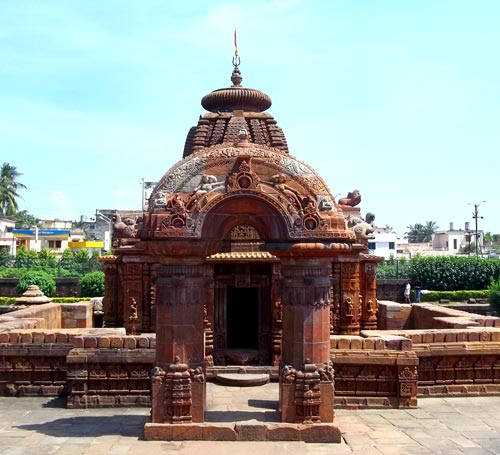
- : Khajuriapada, Narisho, Bhubneshwar, Odisha 752103..
- : One can easily reach Mukteswara Temple by taking regular Buses or by hiring taxis from anywhere in Bhubaneshwar. Nearest Airport -Bhubaneswar: 34 km. Nearest Railway Station-Bhubaneswar : 33km.
- : All days of the week 6:30 AM – 7:30 PM.
- : 45 minutes to 1 hour..
- : .
- : Budget & Luxury Hotels available..
 Basic info
Basic info
An important landmark towards the architectural development of Odisha, the Mukteswar Temple is often times described as one of the jewels of Odisha. With its exquisite scluptures and elegannt looks built in the 10th Century, the temple is dedicated to Lord Shiva and is an important monument for the study of the development of Hindu temples in Odisha. Speculated to be built by Jajati I, the Mukteswar temple, along with Rajarani temple and the Lingaraj temple located in the capital city of Bhubaneswar are claimed to be the most prominent attractions for the temple city of India. It marks as one of the stylistic developments as a culmination of the earlier eras and experiment for developments towards something new.
It’s main attraction is the torana or the elaborately decorated arch which is also the main feature of the temple. It reflects an era of heavy influence of Buddhist architecture. The archway is filled with exquisite carvings of ornaments, beautiful women and other such intricate designs.
The temple’s structure might be seen as regular but what makes it remarkable is its plethora of unparalleled detailed architecture in the entirety of its premises. The windows are diamond shaped and filled with lattice designs.
The temple has many landmarks present near itself one of which is the small but famous Marichi Kund. It was believed that the water from here could cure infertility of women especially during the Rukuna Rath Yatra.
Netaji Birth Place Museum, Odisha.
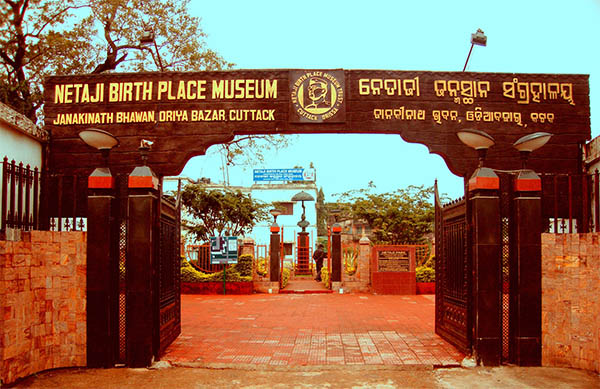
- : Oriya Bazar, Cuttack 753002..
- : Distance from Airport- 33 km. Distance from Railway Station-4.5 km..
- : 10:30 am - 4:30 pm.
- : 1 to 2 hours.
- : .
- : Budget & Luxury Hotels available..
 Basic info
Basic info
If you are a history buff, you are bound to be interested in the Netaji Museum situated in Odia Bazaar at Cuttack.
This museum which is the ancestral house of the great leader and freedom fighter was converted by the Odisha government in Netaji’s memory.
The ancestral house, Janakinath Bhawan named after his father Jankainath Bose was where Netaji Subhash Chandra Bose took birth on 23rd January, 1897 and his life memorabilia is currently been showcased through 15 galleries. At the main entrance stands a large gate with sculptures which showcase Netaji leading his Indian National Army. The one on one side of the road is decorated with graffiti. It is based on the various life stages of the leader and outside the house is a beautiful garden and a replica of a horse carriage used by Netaji.
Inside the museum you’ll get to see one of his rare photos, the letter he wrote to his family during his various jails and his INA uniform among various other artifacts. The entire two storey house with 12 bedrooms has been converted to a gallery and the study room contains the table and chair of Netaji and book shelves while another gallery is a recap on his prison life.
Netaji’s rare letters expressing his views on strong and Independent India are one of the most prized possessions inside the museum.
From 2010 to 2013, the Odisha Government added three more galleries to the museum which includes a special gallery that throws light on the spiritual aspect of Netaji. The spiritual beliefs of Netaji are not well known among people; not many know that Netaji always carried a copy of the Gita, a photo of Goddess Kali and Rudrakshya beads with him.
Rajarani Temple, Odisha.
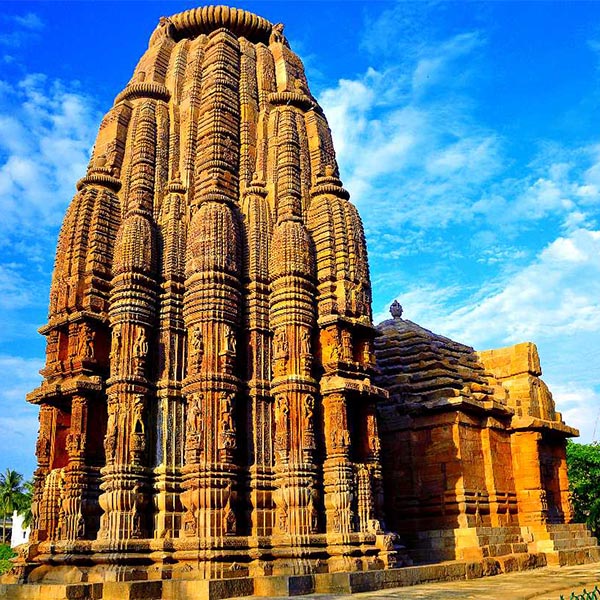
- : Tankapani Rd, Near BOI ATM, Bhubaneswar, Odisha 751002..
- : By Cab or Buses from Airport or Railway station. Nearest Airport-Bhubaneswar- 5.1 km. Nearest Railway Station-Bhubaneswar-3.7 km..
- : All days of the week - 8:00 AM - 5:00 PM.
- : 1 to 2 hours.
- : December - May..
- : Budget & Luxury Hotels available..
 Basic info
Basic info
An 11th century temple originally known as Indreswara, the Rajarani temple is one of the most unique. The temple built in the panchtaratha style it is often times referred locally as the love temple because of the presence of erotic carvings of women and couples. It is built on a raised platform with two structures : a central shrine called the viamana with a bada over its roof. It’s dull red and yellow colour comes from the sandstone used for its building. Its name Rajarani is believed to have come from the presence of Naga and Nagini at the entrance .
The main highlight of the temple are the fine sculptures of the dikpalas or guardians of the eight directions carved all around the shrine starting from Lord Indra in the east, bearded Agni in the southeast, Yama in the south, Nirriti in the southwest and many more. Other sculpture on the wall also depict the scenes of the marriage of Shiva, Nataraja, Parvati and include tall and slender nayikas in various roles and moods such as looking in th emirror and taking off her anklet.
It has successive tiers of projections rising to form the 18m tower.
It has a square sanctuary and its interior and exterior are so recessed that it appears circular. The ornamental deul stands diagonal to the severely plain jagamohana.
It is said that the architecture of many other temples are originated from this, especially the ones in the central India.
The temple contains no images of any deity inside its sanctum but certain features indicate its origin as a Saivite.
Tribal Research Institute Museum, Odisha.
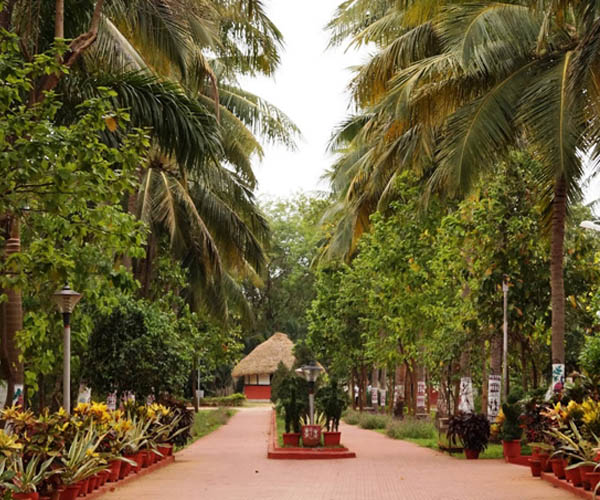
- : Unit - VIII. CRPF Square, Nayapalli, Bhubaneswar, Odisha 751003.
- : Nearest Airport- Bhubaneswar- 6.5 km. Distance from Railway Station-Bhubaneswar-5.2 km..
- : 10:00 AM - 5:00 PM
- : 45 minutes to 1 hour.
- : Throughout the year.
- : Budget & Luxury Hotels available..
 Basic info
Basic info
The Tribal Research Institute museum, Museum of Tribal Arts and Artifacts in Bhubaneswar is a museum located inside the campus of Scheduled Caste and Scheduled Tribe and labeled as Museum of Man.
Present in the museum is the life sized tribal dwellings crafted by tribal craftsmen. It offers a view of the State’s tribal heritage and has sections which showcase tribal artifacts and objects, focusing on well researched, documented cultural life of tribals of Odisha. The administrative control of the museum lies in the hands of ST, SC, Minorities and Backward Classes Welfare Development and is headed by the director who’s currently in the rank of a University professor.
The charm of the museum has made it to be one of the top tourist attractions over the decades for people of all ages. It’s location in the capital city has made it a convenient spot. The museum showcases the culture and livelihood of tribal people of Odisha through a rare collection of clothes, jewelers, musical instruments, tools, weapons and more.
The museum includes 5 life-sized tribal huts built by local tribal artists. These represent the tribe of Juang, Santal, Saora, Gadaba and Kandha. It also includes 5 halls display a great assortment of arts and artifacts depicting tribal lifestyle. The first one includes personal adornments, second and third showcase personal belongings, paintings, art, photographs, weapons of offence and defense, hunting and fishing implements. The fourth gallery consists of housing object and agricultural implements. Lastly, the fifth hall boasts an assortment of dance, dhokra items and musical instruments. In total, there are more 1900 artifacts that give a great insight into tribal people, their culture and way of living.
Turtle Beach, Odisha.
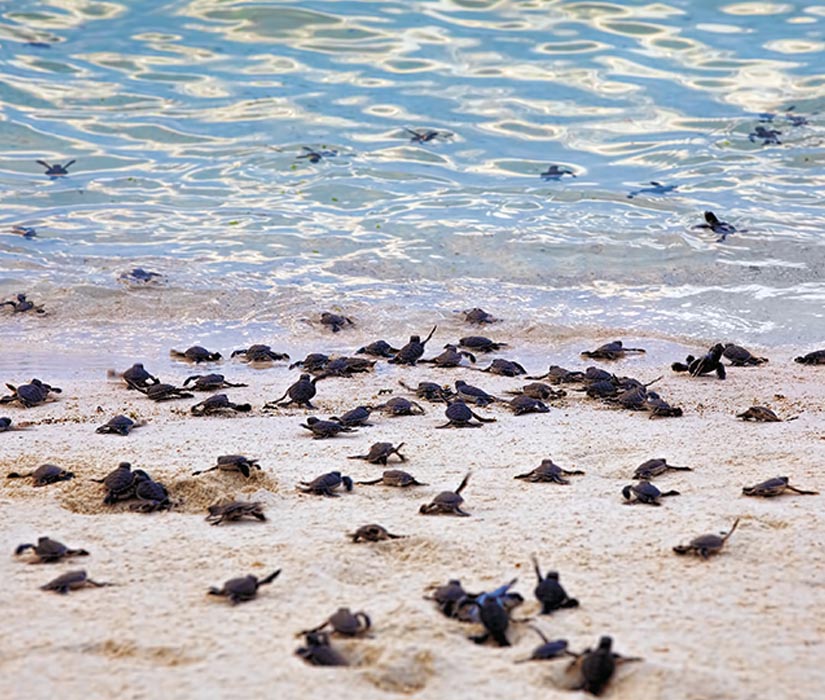
- : Turtle Beach, Gaharimatha, Kendrapada, odisha-754248.
- : Nearest Airport-Bhuabneswar-173 km & Nearest Railway Station-Bhubaneswar-166 km..
- : All the year round.
- : As per convenience..
- : October to March..
- : OTDC (Odisha Tourism Dev. Corp.) provides..
 Basic info
Basic info
Turtle Beach, known by the name Gaharimatha Beach/Gaharimatha Marine Santury, is a part of Bhitarkanika National Park, which is the world’s largest nesting beach for Olive Ridley Turtles followed by coasts of Mexico and Coasta Rica. It is the only marine wildlife sanctuary of Odisha and separates the Bhitarkanik Mangroves from Bay of Bengal.
This breeding ground is located at the confluence of Dhamra river and Bay of Bengal in the Kendrapada District of Odisha in the north and extends to the mouth of Brahamani river in the south which covers about 1435 sq km. This is the place to where the Olive Ridleys travel, from far of Pacific Ocean for mating and laying eggs during the month of November every year. Due to this reason, Gaharimatha Beach was declared as the Turtle Beach Sanctuary by the Government of Odisha in 1979.
Olive Ridley Sea Turtle is classified as vulnerable by the International Union for Conservation of Nature and Natural Resources (IUCN - according to the Red Data Book), and India is a signatory of all these conventions. They are mostly found in the warm and tropical waters of Pacific and Indian Ocean and also in the warm waters of Atlantic Ocean. They are about 2 feet long and have olive coloured rounded and heart shaped carapace. These species are famous for their unique nature of mass nesting (arribada), where lots of female turtles come in large groups on the same beach for laying their eggs.
The Turtle Beach attracts tourist all the year round across the world and is a very nice place for nature lovers. To see the turtles hatch eggs and have an experience, visitors have to wait till night, in there breeding month. The Gaharimatha beach has a very scenic beauty which captivates every individual who ever comes to this place.
Many researchers also visit this place for their study,experiments and observances purpose.
Udayagiri and Khandagiri Hills, Odisha.
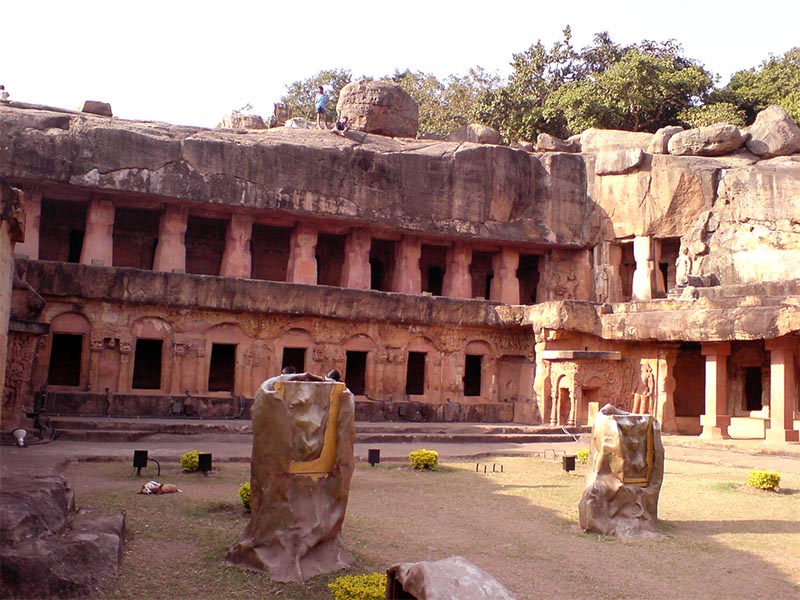
- : Khandagiri, Bhubaneswar, Odisha 751030..
- : Nearest Airport-Bhubaneswar- 9.1 km. Nearest Railway Station-Bhubaneswar-3.7 km..
- : All days of the week 10:00 AM - 5:00 PM.
- : Around 2 to 3 hours..
- : September - May..
- : Budget & Luxury Hotels available..
 Basic info
Basic info
The Udaygiri and Khandagiri caves are one of the earliest Jain rock cut shelters which command a unique position in the file history of rock architecture, art and religion. The Udaygiri (Hill of Sunshine) and Khandagiri (Broken hills) rise abruptly from the coastal plain about 6km west of Bhubaneswar and are separated by a highway.
The Iena or insciptions on the caves are essentially dwelling retreats or cells of the Jain ascetics opening directly to the open space or verandah. Excavated near the top ledge or boulder, the provided dry shelter for meditation and prayer with very little amenities even for small comforts, the height too low to allow a man to stand erect.
A single cell was tenanted by several monks who are austerely plain but their facades are encrusted with sculptures depicting auspicious objects worshipped by Jains, court scenes, royal processions, hunting expeditions and scenes of daily life. The later addition when Jainism no longer enjoyed royal patronage shows 24 Jain tirthankars.
Presently, all the caves have been numbered to avoid confusion in nomenclature.
The caves located on two adjacent hills have a number of finely ornated caves built during 2nd century BCE . The popular belief is that the caves were carved out as residential block for Jaina monks during the reign of King Kharavela.
In total the Udaygiri has a total of 18 caves while Khandagiri has 15 caves.
The cave was most likely to be a center of astronomy and Hindu calendar-related activity, given its sculptures, sundials and inscriptions. Udaygiri’s Hindu history long predates the 4th century.
The caves were likely first modified by King Samudragupta in the mid 4th century and a few decades later reworked on by his descendant Chandragupta II to revitalize the concept of Hindu king to both the paramount sovereign and as the supreme devotee of the god Vishnu.








